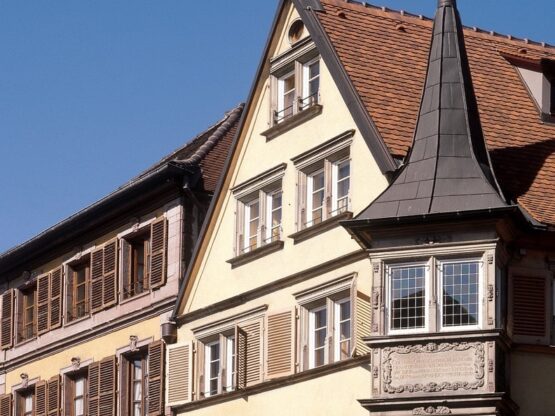Phone : +33(0)3 89 24 11 51
Adresses à découvrir sur Colmar
History of the hotel
History of the Old House "Zum Rosengarten
The building no. 38 of the Grand'Rue in Colmar appears very early in the documents as the house "Zum Rosengarten" (At the rose garden) 1361 - 1575.
In 1443 it was an inn. The present building dates from the 18th century, around 1770. The first floor, with its three basket-handle openings, is topped by three floors. In 1903 it belonged to the Eugen Braetz family: Blaukreuz restaurant. In 1920, it was owned by the Blue Cross, which had set up a non-alcoholic restaurant there.
At the back of the old house is one of the most interesting stone staircases of Colmar, serving a Renaissance turret dating from 1608. It leads to an inner courtyard with a vaulted cellar. A second building, with wooden panelling, overlooks this inner courtyard, dating back to at least the 17th century. It was consolidated by four irons in U, in the iron age. This building was rehabilitated in 1987.
To this building was adjoined an old house, worthless, in poor condition, listed as to be preserved or demolished. We know nothing about the past of this building.
Formerly called "Zum Rosengarten" (At the Rose Garden), the former Gothic hostelry from 1361 was transformed into a French Baroque building in the 18th century. The entire exterior architectural decoration, dating from 1760 and made of pink sandstone, bears witness to this transformation, with its first floor of arcades supporting two floors of windows separated by a long band of sculpted frieze. The frames of the bays and the arcades are decorated with beautifully crafted mascarons. Inside, only the superb stone spiral staircase, dating from 1608, the door lintels, as well as the vaulted cellars on crossbeams falling on a central column, still attest to the age of the place. On the rear façade, the building opens onto a romantic interior courtyard, dominated by the stairwell and a half-timbered wall from the 16th century. In a corner, the stone basin of an ancient well reveals a date: 1781. Although very different from the first, the second building also has a very old history, since it was already called "Haus zur Sonne" between 1325 and 1542.


Known to all Colmarians and mentioned in tourist guides, the 3rd building of great beauty dates from 1668 and remains a magnificent example of late Renaissance architecture. Built on the site of a 15th century building, the building was the work of André Sandherr, the famous "Obrist-Stettmester" of Colmar, whose Latin dedication can be found on a cartouche of the oriel: "André Sandherr Obrist-Stettmester of his native town of Colmar and his wife Cléophe Wezel have built this house. Passers-by, do not be jealous but take example, and pray to God on your knees to protect this work"... A very beautiful corner oriel protrudes between the two wings of the building, richly sculpted on three sides and pierced by two levels of mullioned windows. On the façade there are two large cartouches with scrolls, one of which, on the first floor
one of which, on the first floor, preserves the Latin dedication, and the other the date 1668 between two coats of arms hammered out during the Revolution. An imposing double-storey gable enhances the whole building and is surmounted by a bust of a character with a head wearing a bicorn.
